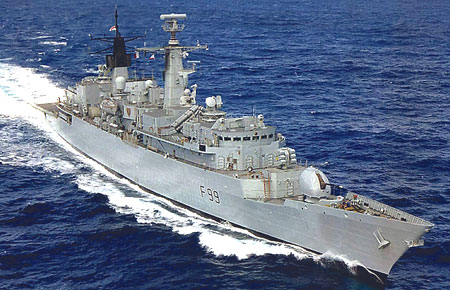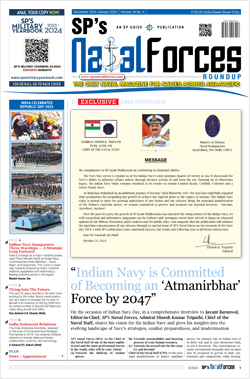INDIAN ARMED FORCES CHIEFS ON OUR RELENTLESS AND FOCUSED PUBLISHING EFFORTS

The insightful articles, inspiring narrations and analytical perspectives presented by the Editorial Team, establish an alluring connect with the reader. My compliments and best wishes to SP Guide Publications.

"Over the past 60 years, the growth of SP Guide Publications has mirrored the rising stature of Indian Navy. Its well-researched and informative magazines on Defence and Aerospace sector have served to shape an educated opinion of our military personnel, policy makers and the public alike. I wish SP's Publication team continued success, fair winds and following seas in all future endeavour!"

Since, its inception in 1964, SP Guide Publications has consistently demonstrated commitment to high-quality journalism in the aerospace and defence sectors, earning a well-deserved reputation as Asia's largest media house in this domain. I wish SP Guide Publications continued success in its pursuit of excellence.
- MoD initiates comprehensive review of Defence Acquisition Procedure 2020, pushes for defence reforms
- G7: The Swansong
- Kalinga Connect: South Asia to Polynesia
- Advanced MRSAM for India for a greater firepower
- Must Credit DRDO for Operation Sindoor, now what is next for defence R&D?
- Operation Sindoor | Day 2 DGMOs Briefing
- Operation Sindoor: Resolute yet Restrained
Anti-Submarine Warfare
Makeover Mantra

Since the legacy ASW in its current form is not effective, navies need to reacquire ASW in its new avatar—an avatar which will effectively counter the enhanced threat of Air Independent Propulsion submarines
Potential threats to control over sea areas will always remain unaccept-able to any maritime nation. Since the submarine threat is among the gravest of these, effective Anti-Submarine Warfare (ASW) capabilities will be the sine qua non for success in future crises and conflicts. ASW, therefore, remains the linchpin of sea control. This is no less true now than it was during the cold war and is applicable to all navies—global, regional or coastal—and in all waters, blue, green or brown. Despite the advance of technol-ogy, ASW has and continues to remain a complex challenge with neither simple nor elegant solutions. However, the era of tra-ditional anti-submarine warfare is over.
Blue Water ASW
Yet the ghost of those times continues to haunt the ASW fraternity in terms of archaic organisations, tactics, hardware and perhaps, most importantly, mindset. The nations involved in the cold war were also the only ones with the economic clout to indulge in R&D in the field of ASW. The thrust of ASW remained the cold deep-blue oceanic waters and the enemy, predomi-nantly the nuclear powered submarines. The hardware, tactics and training con-cepts developed by these navies did not address the acoustic and physical vagaries of the green and brown waters and the silent conventional submarines.
Nations dependent on these Cold War players for their ASW platforms, weapon and sensors were, therefore, at times sad-dled with ASW wherewithal not suitable for their waters of interest, green and brown, and their threat, the conventional subma-rine. The only exception were Sweden and a few other European maritime nations, who were interested in shallow water ASW and, therefore, developed weapons and sensors specific to their needs. The Swedish Sonar Didon, with its associated ASW mortar, the SR 375, and the German wire guided tor-pedo, SUT 266, are two examples of shallow water ASW weapons.
AIP Technology: The emerging threat
Today, there are more than 43 states in the world operating conventional submarines. Most of these are the 3rd Generation SSKs and an increasing number of navies are acquiring the Air Independent Propulsion (AIP) capable 4th Generation SSKs. These subs are exponentially more dan-gerous and lethal than the Foxtrot and Juliet classes of diesel-electric subma-rines and their western counterparts. The projection is that number of states deploying SSKs will increase and those that have them will modernise existing submarines and expand their fleets.
The most significant performance enhancer for conventional diesel-electric submarines has been the AIP. While the best of the conventional boats like the German 209 or Russian Kilo can remain submerged on battery at low speed for periods to the order of three to five days, available AIP schemes can increase slow speed endurance to as much as three weeks or a month. While still dwarfed by the potential of nuclear power, nations unwilling or unable to accept the high cost of nuclear power are turning to the lower priced and less ambitious AIP alternative to achieve significant operational advan-tage of greater underwater endurance and longer range.
Current ASW legacy
With the new world order, not only the global but even the regional navies need to have their maritime strategies refocused towards forward presence, expeditionary warfare, conflicts in the lit-torals and the ability to influence battle on land through maneuver from the sea. The existing ASW capabilities which were painstakingly created during the cold war era are, at best only partially adequate for the new and different environment that prevails today. Shallow water, near-shore oceanographic phenomena, asymmet-ric diesel and advanced AIP submarine threats and the meager information about the potential battle space; all contribute towards the inadequacy of our ‘ASW Legacy’ to contain the current undersea threat. Further, if a current or potential adversary also operates even a limited number of state-of-art nuclear submarines with global reach, the so called Cold War threat also needs to be countered.
Since the legacy ASW in its cur-rent form is not effective, navies which want to remain relevant in the new world order, need to reacquire ASW in its new avatar—an avatar which will effectively counter the enhanced threat of AIP sub-marines in the shallow near coast waters. The attempt here is to postulate certain changes in the existing three paradigms of ASW—technology, operational concepts and training techniques. As a precursor to these proposals, it would be pertinent to study some fundamental truths about ASW, have an overview of AIP technology and understand Hydrology in shallow and near-shore waters.
Fundamental truths about ASW
Critical to Maritime Strategy: Some 2,400 years ago, Chinese military strategist Sun Tzu recognised that the best way to defeat an enemy is to attack his strategy. ASW is critically important to any nation whose maritime strategies include sea control, power projection and direct sup-port to the battle on land. A submarine threat that denies frustrates or delays sea-based operations, clearly embodies Sun Tzu’s dictum by attacking the strat-egy directly.
During the 1982 Falkland conflict, while the Royal Navy established ‘regional maritime battle space dominance’ with a single submarine attack sinking the cruiser General Belgrano, had any of the torpedoes launched by the single Argentine Type 209 submarine, San Luis hit one or more ships of the Task Force, the outcome of the conflict would have been entirely different. The cause was an ill-maintained fire control system onboard the submarine rather than any concrete action or measure by the ASW forces
About team work: ASW requires a plethora of diverse capabilities, all working in uni-son, in a constantly changing physical environment. No single platform, system or weapon will fit the bill. To ensure ‘four dimensional protection’ (space got added to the existing three), we need a wide range of undersea, surface, airborne, and space based systems. ASW demands a multi-disciplinary approach, subsuming intelligence, deep understanding of ocean-ography, surveillance and cueing, multiple sensors and their technologies, coordi-nated multi-platform operations, and the entire spectrum of underwater weaponry. And above all, ASW requires highly trained, skilled and motivated people.
Hard and unglamorous work: The San Luis operated in the vicinity of the British task force for more than a month and was a constant concern to Royal Navy com-manders. Despite the deployment of five nuclear attack submarines, 24-hour per day airborne ASW operations and expenditures of precious time, energy, and ordnance. It was not detected even once despite having penetrated the ASW screen on more than one occasion and retreated after torpedo launch, albeit without a hit. And the primary task of the Royal Navy within the NATO was ASW. To enhance the glamour quotient, wish some one produced a movie titled, say, Top Bunk, with Tom Cruise as an ASW officer on an ASW platform.





